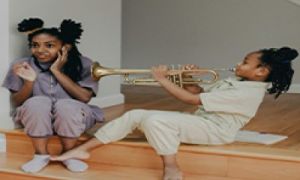A resume is your first impression in a one to two page document that sums up your work qualifications, experience, skills and teaching philosophy. It's important to have a resume that outlines your achievements and experience in a short, concise and efficient way in order to attract an interview.
Writing A Resume
When applying for a job within an early childhood service, the director or management takes an average of 5-10 seconds to look through your resume. Within that limited time, they will decide whether or not to call you for an interview.
It's so important to make your resume stand out and to make sure you interest the employer.
So let's look at what you need to include on your resume:
- Contact Details - You only need to include what's relevant. Such as name, address, telephone numbers etc. You do not need to include your date of birth, your family details, religious background, marital status etc. Make sure that you have a professional email address. Your name, address, phone number and professional email address should be displayed prominently at the top of your resume. It is best practice to use your full name (not a nickname).
- Career Objective - Write your career objective back to the job you have applied for with an overview of your key achievements. It should tell the employer what position you are applying for, the level of responsibility you want and where you see yourself in the future. Explain why you are looking for work (example: you want a new challenge, you want to upskill etc.), what you are looking for in your next job (list the actual job titles) and why you are qualified to apply for these roles.
For example - Having worked within the early learning industry for (x) amount of years, I have extensive experience working as (job title). I am currently seeking a new challenge and exciting work environment where I can utilise my skills (list your skills here), and knowledge (in the areas of x, y z) to achieve (x,y,z outcomes). - Key Strengths - This section of your resume should be in dot-point (up to 10 points) and outline your key skills and attributes, such as 'effective communicator', 'organised', 'energetic'.
- Employment History - When listing your previous employment history, start from the most recent. Include, company/centre, location, position held, key skills/job responsibilities. Add years rather than months of when you started and finished. e.g. "2015-2016".
For example -
- Job title
- Name of employer (and the address or suburb of where it was located)
- Dates of employment
- List of key responsibilities and achievements (Hint - try to put yourself in the mind of your potential employer - what type of keywords and key responsibilities would they be looking for as they scan each resume? Make sure you not only list your day to day duties, but also how the centre you worked for benefited from your contribution)-
- Any awards or recognition you may have received during your time at this company - Work Experience - For students who don’t have employment history to add in their resume, you could add your practical placement or voluntary positions you had held. Add the name of the centre/company where you did your placement, how long you were there for placement (e.g. 35 days) and highlight your responsibilities and your duties during your work placement. You could also include a brief summary of what you were required to do, what you did and how you did it, the results of your actions and what you learnt.
- Education and Qualifications - Your education and training section can cover anything from university degrees, TAFE diplomas and certificate courses plus any other professional training you may have undertaken. Start with the most recent and list the qualifications you have obtained, year it was completed and the institution where you had studied. You could also include short training courses, workshops, forms of accreditation etc. A good format to follow is:
- Name of degree/diploma/certificate etc
- Name of education institution
- Location of education institution
- Graduation date
- Any course credits or key achievements pertaining to this course (e.g. Finished in top 5% of class with high distinctions) - Hobbies/Interests (optional) - It is sometimes worth including a short list of your hobbies and interests to give them a sense of who you are and what you enjoy doing outside of work hours.
- Referees - Always ask for permission before listing someone as a reference. Include details of a minimum of two referees (former employers, supervisors from work placement, mentor etc.). Referees are used by future employers to speak about your skills, work role, personal attributes etc. Make sure you keep your referees informed so they are prepared. You don't need to include your referees on your resume you could just add "Contact Details Available On Request" and once you have an interview you could provide the employer the details at that time. A good format to follow is:
- Full name of referee
- Job title of referee
- Company name of referee
- Location of company
- Phone number of referee
- Email address of referee
Aim to highlight your strengths, skills, experiences and achievements and only include information that reflects you positively. Your resume should show your employer that you have what they are looking for.
How Your Resume Should Look
Your resume should be easy for an employer to read quickly. The length of your resume should be 3-4 pages long . You don't need to include all your work and life history. Make sure it is relevant to the position you are applying for.
Here are some tips when writing up your resume.
- There are plenty of templates online that will enable you to fill in to create your resume. These are fine for you to use but make sure that the layout is professional.
- Include page numbers.
- Always check for spelling mistakes and ask someone to read over it for you.
- Adding a photo to your resume is up to you however think about how your photo may be perceived e.g. you could be inaccurately perceived as too young/too old/inexperienced/serious etc. Instead add it to another copy of resume to give to the employer after your interview so they remember who you are.
- If you don't have much experience working in child care, focus on what you have done rather than what you haven't. Highlight the specific, skills gained from your experiences.
- If you have had similar positions, list each position than do a summary of skills under this, rather than repeating similar duties and responsibilities.
Writing A Cover Letter
A cover letter should always be included when submitting your resume (unless it specifically says not to include one). It should include:
For An Advertised Job -
- Your name and contact details (home number, mobile number), and your professional email address.
- The job you are applying for (e.g. "RE: Application for Diploma Qualified educator position).
- List of your relevant skills and experiences (a short bullet list is fine). If the job you're applying for mentions "key selection criteria" you need to respond to all these items but remember to keep it short.
- Once you have listed your skills and experiences you need to explain why this means your suited to the job.
Your cover letter should encourage the employer to want to read your resume so at the end of the cover you could end it like this "I have attached a copy of my resume for your consideration. I look forwards to hearing from you about this application" .
For No Job Advertised -
- Mention you’re interested in their centre and working for them.
- Get to know a little about their centre/company and how your skills and experiences fit into their goals (find their website and go through the information).
- Let them know what you are hoping to get out of contacting them e.g. if there are currently positions available.
- You could end the cover letter by saying that you will contact them in a couple of weeks to follow up, however you are delighted to talk to them if they contact you before then.
When you have submitted your resume and cover letter, if you haven't heard back in a couple of weeks, you may contact them and ask them if they had received your application and their response. You may contact them through email by its best to call directly and speak to the directly.
With this guide, it will give you the confidence to write a resume so go on and apply for that position!
Good Luck!
References:
- Writing A Resume - Future Education, Melbourne Australia, 2012
- Resume Writing - Education, Careers QLD, 2013
- Writing A Cover Letter, Youth Central Victoria







 As an Educator in Australia, your pay rate falls under the Children’s Services Award 2010. This award states the minimum amount that an employer can
As an Educator in Australia, your pay rate falls under the Children’s Services Award 2010. This award states the minimum amount that an employer can When working as a qualified Early Childhood Teacher (with a university degree) within a service, your rate of pay will come from the Educational Services
When working as a qualified Early Childhood Teacher (with a university degree) within a service, your rate of pay will come from the Educational Services When working as a Diploma Qualified Educator your pay rate is from the Children's Services Award 2010. This Award states your minimum rate of pay
When working as a Diploma Qualified Educator your pay rate is from the Children's Services Award 2010. This Award states your minimum rate of pay When working as a Cert 3 Qualified Educator, your pay rate is from the Children's Services Award 2010. This Award states your minimum rate of
When working as a Cert 3 Qualified Educator, your pay rate is from the Children's Services Award 2010. This Award states your minimum rate of Educational Leaders play a crucial role in their early childhood service by ensuring that the educational program aligns with best practices and supports the holistic
Educational Leaders play a crucial role in their early childhood service by ensuring that the educational program aligns with best practices and supports the holistic In early childhood education and care, ratios are more than a technicality—they are a frontline safeguard. Every child deserves responsive supervision, emotional connection, and developmental
In early childhood education and care, ratios are more than a technicality—they are a frontline safeguard. Every child deserves responsive supervision, emotional connection, and developmental With the new national child safety reforms kicking in on 1 September 2025, early childhood services like yours have a real opportunity to lead the
With the new national child safety reforms kicking in on 1 September 2025, early childhood services like yours have a real opportunity to lead the Here’s a comprehensive Mobile Phone and Smart Watch Policy tailored for early childhood education and care (ECEC) services in Australia, aligned with the latest 2025
Here’s a comprehensive Mobile Phone and Smart Watch Policy tailored for early childhood education and care (ECEC) services in Australia, aligned with the latest 2025 The Sea of Fish Challenge is a national initiative that invites children, educators, families, and communities to create and display fish artworks as a symbol
The Sea of Fish Challenge is a national initiative that invites children, educators, families, and communities to create and display fish artworks as a symbol Across the early childhood education and care sector, educators are sounding the alarm: current staffing ratios are insufficient to deliver safe, meaningful, and developmentally appropriate
Across the early childhood education and care sector, educators are sounding the alarm: current staffing ratios are insufficient to deliver safe, meaningful, and developmentally appropriate


